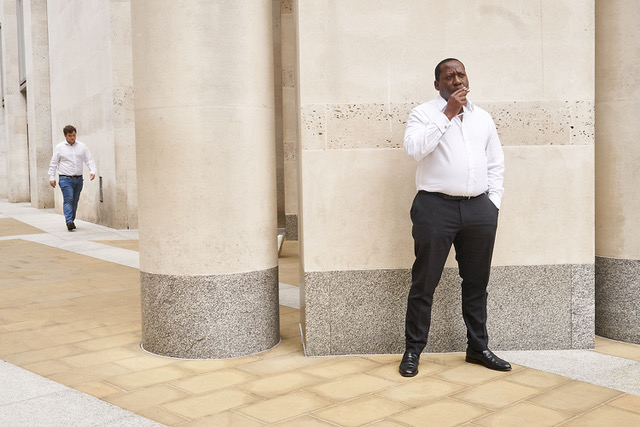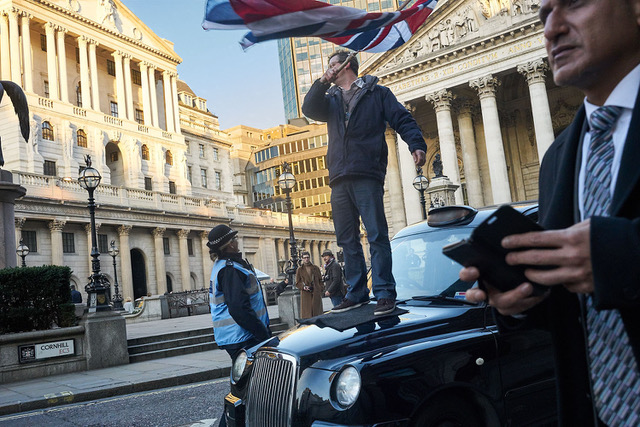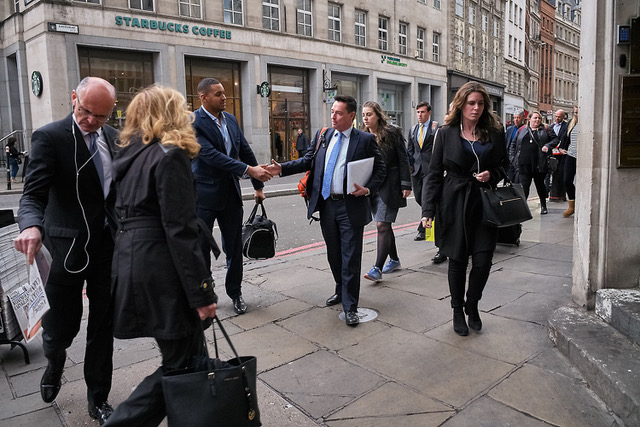Michael Wayne Plant is a Creative Londoner too humble to call himself an artist, but his work in photography shows a great depth of critical artistic thinking. I meet the photographer in a pop-up café beneath St Paul’s Cathedral, one of his regular pit stops when out shooting London’s financial district.
‘I met someone who has endorsed me to become a Freeman of the City’, he says, as he ends a phone call and shakes my hand. He had got talking with some city worker in his 90s who still goes to work at Lloyds part-time because he enjoys it, he tells me. ‘It’s amazing the range of people you meet as a street photographer.’
I notice the retro-styled Leica M10 with a manual focus 28mm lens tucked beneath a steaming coffee machine and a carefully assembled stack of cups.
Michael Wayne Plant is a professional photographer whose work has spanned a number of genres, including fashion, portrait and corporate photography.
But his current chief artistic and intellectual focus is social documentary photography. Taking elements from street photography, social documentary photography looks at the street as it is constructed socially. It aims to capture the image of contemporary society.
His career began in portrait and fashion photography. Leaving school at the age of 15, MWP worked his way up through the ranks quickly, making quite a name for himself in the industry. He moved from his native New Zealand to London in the 1990s, working for top clients, among them Elle, Cosmopolitan and Empire. But becoming increasingly conscious of the risks of conforming to industry stereotypes, MWP took a decisive break from the fashion industry.
But he never put down the camera. After some years teaching photography, he turned to social documentary photography, and went further by developing his artistic sensibility with an MA in Photography and Urban Cultures at Goldsmiths in 2008.
Creative Londoners: What is it about social documentary photography that inspired you to begin working in the genre?
Michael Wayne Plant: I am interested in both photography and how the world works. Social documentary photography has a rich history of story telling and raising awareness of issues that need addressing within our world. I work in this tradition because I think that the world’s balance is in need of fixing and I felt compelled to try to make a difference. Some people write, but when I realised my form of communicating is photography it became obvious that this was the media and tradition I would use.
“Social landscape” is an idea that has stuck with me. It comes from a Bruce Davidson, Lee Friedlander, Garry Winogrand, Danny Lyon and Duane Michael exhibition called “Towards a Social Landscape”. I am interested in the idea of the social landscape that we inhabit. As our society creates landscape socially, it is important to feature both the people who I am interested in and the space/place they use. I engage with social landscape as a terrain of socially constructed meanings that are not necessarily fixed.
He also realised that the internet is not only an incredibly powerful marketing tool for a photographer, but has the potential to reach a great enough audience to sustain the projects he wanted to take on. His turn to social documentary work is figured out in line with his ideas about how to harness the social potential of the web to produce it.
CL: Where does the internet come in to your work in social documentary?
MWP: Photographers have the ability with the internet to develop work that is narrow in focus, as no matter the subject, there will always be an audience interested in it. The idea for marketing photographers is no longer local.
Photographers – actually anyone creative – can now find an audience globally, even for a narrow subject. Prior to the internet, if you wanted to make money as a photographer you needed to have a broad enough potential client base in your local area to be able to work.
With the internet, the cost of marketing your photography has become the same whether you are doing it locally or globally. So instead I can find people in Asia, Africa or South America interested in my work just as easily as here in London. A narrow focus, but global audience, can be better than a broad-based audience in a local area as it lets you specialise in your area of expertise and interest.
Around the same time as he began using the internet for his projects, MWP developed an interest in neoliberalism. He was curious about the way in which it structures contemporary society. MWP noticed that the biggest industry in the world was financial services. But rather than purely document the products of neoliberalism that we see in everyday life, MWP was interested in what is not visible to most in everyday life, with its centre of activity confined to a couple of small areas of London.
Wanting to document the elusive ideology, he took to the City with his camera to begin developing what he is now calling his ‘City of London’ project. The following photos are from the collection.

CL: Which part of the process of social documentary photography do you most enjoy?
MWP: Storytelling: discovering a story and then developing a way to tell that story visually. It’s difficult as I am trying to show a concept (i.e. how capitalism functions) as concept I have to show its consequences in its built environment which is why the idea of a social landscape is so interesting for me.
Beginning in January 2016, Brexit had a big impact on the City of London project: MWP began to realise more what the story his photographs were telling might be about. A marked, sudden change occurred in the conversations MWP was hearing in the City streets after with the shock EU referendum result in June 2016; confidence became uncertainty.

CL: What prompts your finger to press the shutter?
MWP: It is a complex and instinctive process. I am looking to make complex images – ones where there is more than a central focus on one aspect. To do that has meant that I have had to learn to work instinctively. In their book called “On Being a Photographer”, David Hurn and Bill Jay discuss how a good photographer works. They say that best photographers all work in a similar way and I must say I agree with this.
You spot something that gets your attention, you make an image, you realise that something you want is missing from the frame so you add it by moving a little to the left or right, or change view point lower or higher, then make another image, and then decide that you want to remove something so step closer to the thing you are photographing and make another image. This making of multiple images in quick succession is an intrinsic part of making better images, and something that takes practice to get good at.

CL: What prompted you to take to the City of London for the first time for this project?
MWP: Access and availability. For photography to be good, you need to be able to access the subject you want to photograph and repeatedly return to your subject so you can learn and develop your approach to making the visual story you want to tell. The street is a place of dynamic change and I find that exciting. It is not an easy thing to photograph strangers, especially when you are using people as archetypes for something else, so it takes time to learn the patterns of a city and the way things operate. It’s important that you can go back as often as possible.

‘Access and availability’ to the City have become significant assets that inform his project. MWP also provides commercial photography services for City clients. For MWP, this is key to giving his work leverage. In order to understand the City – capitalism – we must get inside it.
See Michael’s website, www.michaelwayneplant.com.
Catch a selection Michael’s work at Four Corners Gallery, 121 Roman Road, 17 — 28 October www.fourcornersfilm.co.uk/LCN-exhibition.
See his commercial photography website at www.photofinance.org.
You can also follow him on his Instagram.




Reblogged this on art & creative culture.
LikeLike